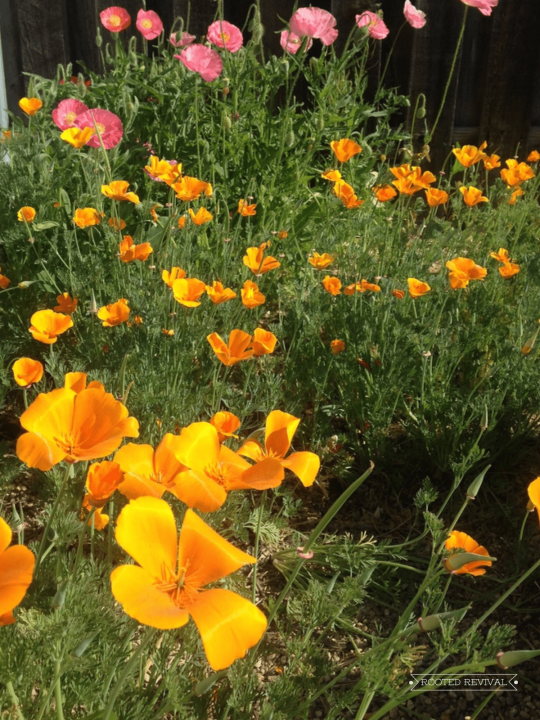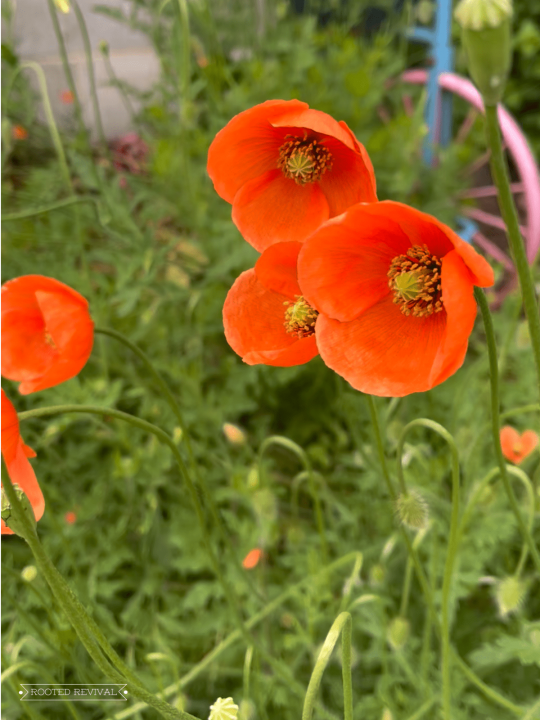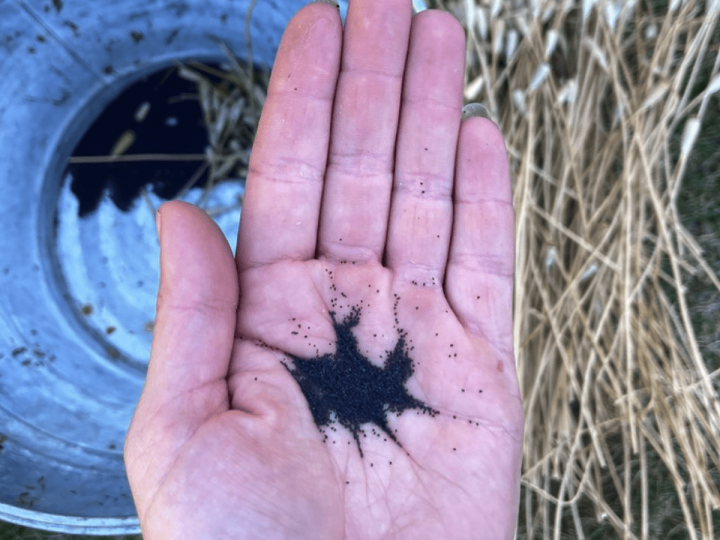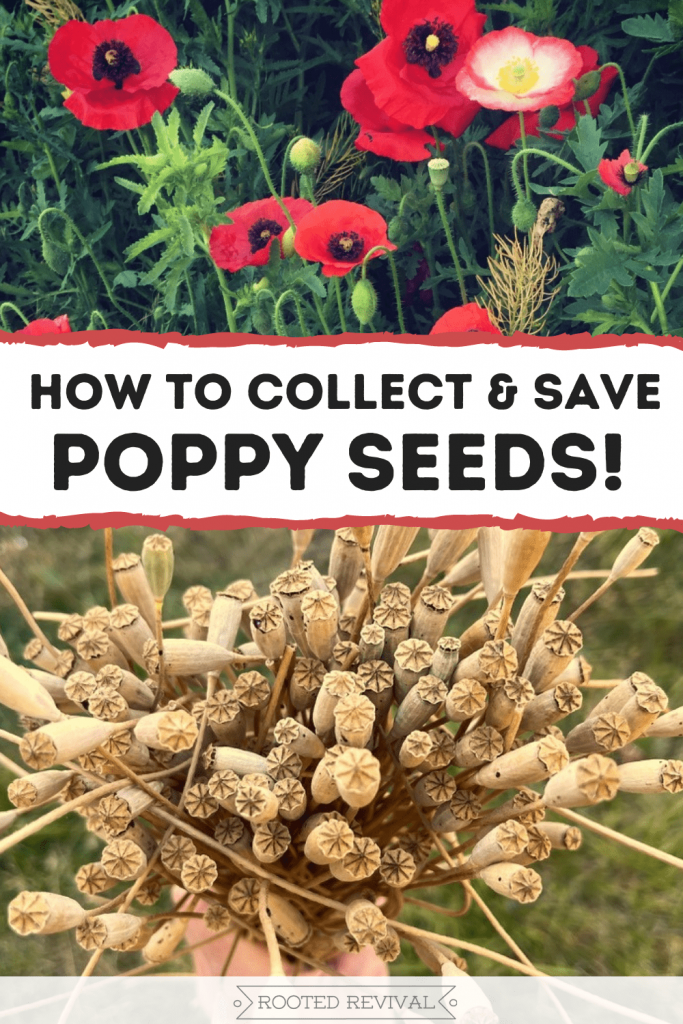Poppies are easy to grow flowers that will add a pop of color to any garden space! Best of all, they are incredibly easy to seed save from! Here’s how to save poppy seeds for endless amounts of flowers!
Poppies, poppies, poppies!
(Okay, soooo sorry but I just had to get it out of my system!)
Poppies are a show stopping flower to add to any garden space! Their bright petals and nodding heads are perfect for cottage gardens, pollinator gardens and meadow gardens. Plus, there are so many varieties and colors to choose from!
One of the best things about growing poppies is that they are virtually fuss-free! Honestly, if you need a bright pop of color but have zero effort to give, poppies are for you, my friend!
Poppies are easy to sow, easy to grow and don’t need much water. They will grow in a variety of terrains and soil types. And, while some poppy varieties are perennials and others are annuals, they will all happily reseed themselves!

Speaking of reseeding, it is also incredibly easy to save the seeds of the poppy flower. Saving your own seeds will allow you to have ample amounts of seeds to spread in new garden spaces or share with friends! And each poppy seed head contains HUNDREDS of seeds! So you will never, ever run out of seeds to share!
** This post contains affiliate product links. I may receive a commission at no additional cost to you from purchases made through links in this article. Full Disclosure Link **
Popular Types of Poppies
Common Poppy (Papaver rhoeas)
The common poppy, also called “corn poppy”, is the “traditional” red poppy that is used as a symbol of rebirth on Veteran’s Day (although there are multiple colors depending on variety!). This poppy is extremely resilient and prefers poor, disturbed soils, making it ideal for hillsides or other areas that are hard to cultivate. It actually became a symbol for veterans because of how it sprang up on ravaged battlefields after WWI.
Buy Common Poppy Seeds from True Leaf Market

Opium Poppy (Papaver somniferum)
The opium poppy, also called “breadseed” poppy, produces the edible poppy seeds that we all enjoy on our everything bagels! This poppy can also be used to produce opium narcotics. Because of that, growing this type of poppy is a legal gray area. And I’m no lawyer, so do your own research. But I certainly would’t want to find myself in a federal prison because I was growing and saving these seeds! Regardless, they are stunning flowers!
Oriental Poppy (Papaver orientale)
The oriental poppy is often seen in gardens and it’s easy to understand why! The large blossoms are truly eye catching! The blossoms bloom on 2-3 foot tall flower stalks and usually bright red or orange. However, there are some varieties that can be other colors, like pink and even purple!
Buy Poppy Seeds Mix from True Leaf Market

California Poppy (Eschscholzia californica)
The state flower of California is a common flower to see bobbing its bright yellow head along ditches and roads. These poppies are generally smaller and do not get as tall as other poppy varieties. They are a popular flower for herbalists to grow because all parts of the plant can be used as a gentle nervine in tonics and tinctures. I made a California poppy tincture several years ago. It tasted like piss but it was very calming once you get past the taste! LOL!
Buy California Poppy Seeds from True Leaf Market

Iceland Poppy (Papaver nudicaule)
Iceland poppies are another gorgeous variety! They are normally yellow, orange or white, although there are many cultivars available! These poppies prefer cooler weather and do best in areas with cool summer seasons. These poppies are great choices for cut flower gardens because they last quite a bit longer than other varieties once cut.
Buy Iceland Poppy Seeds from True Leaf Market
Long-Headed Poppy (Papaver dubious)
Long-headed poppies grow best in disturbed, sandy soils. They are generally a light red color and have 4 large petals that form the flowering head. It’s easy to confuse this poppy with the common poppy, but there are subtle differences, like the lighter color, the lack of a block spot at the base of the petals and hairs that lay flat against the flower stem.

Growing Poppies from Seeds
Poppies are incredibly easy to grow from seed. In fact, they are much easier to grow directly from seed because they do not transplant well.
You can plant poppy seeds in fall or early spring. If you plant in spring, it will probably take 2 years to get blooms. Whereas if you plant the seeds in the fall, you will most likely see blossoms the following summer. Poppies also germinate better after being exposed to a period of cold weather (a process called “cold stratification” which is necessary for many wildflowers to germinate).
Poppies are light-dependent germinators, which means that the seeds need sunlight in order to germinate. Because of this, it’s important to not plant poppy seeds deep in the soil. I like to spread the seeds on the ground or prepared planting space and gently rake them in.
Poppy seeds will grow in a variety of soil conditions, but will do best in full sun.

How to Save Poppy Seeds
Once your poppies are established, it’s easy to save the seeds from your own poppies, allowing you to plant more or share them with friends!
Visual learner?
Watch my YouTube video demonstrating how to save poppy seeds!
Each flower will form a large amount of seeds that are safely tucked inside the seed pod. As the petals die back, the plant will focus on ripening the seeds. If you do not want your poppies producing seeds, you can cut the flower heads shortly after they are done blooming.
If you want to save poppy seeds (or just let the plant reseed), allow the plant to continue ripening the seed pods after the blooms have faded. After several weeks, the plant will start to dry out and die back. At this time, you can begin collecting the fully developed seeds from the seed pods.

To collect your poppy seeds, cut the flowering stalks of the flowers after allowing them to dry for a few weeks. Cut the stems carefully as seeds will easily spill out of the seed heads. Turn the cut flower stems upside down over a bucket or container and shake them to release the seeds.
Alternatively, you can gather the seed heads and spread them in the area where you want new flowers to develop.
Once collected, save poppy seeds in an airtight jar, paper envelope or plastic bag. Label with the variety type and the date collected. Poppy seeds can stay viable for many years. but should be stored in a cool, dark, dry place.
Pin this post for later!


